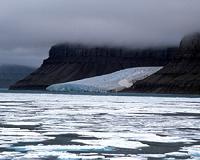| . |  |
. |
Paris (AFP) Jan 21, 2011 Greenland's icesheet, feared as a major driver of rising sea levels, shed a record amount of melted snow and ice in 2010, scientists reported Friday, a day after the UN said last year was the warmest on record. The 2010 runoff was more than twice the average annual loss in Greenland over the previous three decades, surpassing a record set in 2007, said the study, published in the US-based journal Environmental Research Letters. Ice melt has now topped this benchmark every year since 1996, according to the paper, derived from long-term satellite and observational data. Were it to melt entirely, Greenland's icesheet would drive up ocean levels by some seven metres (23 feet), drowning coastal cities around the world. No credible projections today include a doomsday scenario for the coming centuries. But recent research, including the new study, suggest that Greenland will contribute more to rising seas than predicted only a few years ago. Based on computer models, Tedesco estimated that runoff in 2010 was 530 gigatonnes, or billions of tonnes, compared to an average of 274 gigatonnes for the period 1958-2009, and 285 gigatonnes for 1979-2009. "The process is far from being linear, and it is not possible to simply draw a line" into the future, said lead researcher Marco Tedesco, who heads the Cryosphere Processes Laboratory at the City College of New York. But over the last 30 years "there has been an increase in runoff," he said in an email exchange. Researchers have thrown up different figures for how much, and how fast, Greenland is shedding its icy mantle, which is up to three kilometres (1.7 miles) thick in places. They concur, though, that climate change is largely to blame: temperatures in the Arctic region have risen at two to three times the global average over the last 40 years. In Greenland, summer temperatures in 2010 were 3.0 degrees Celsius (5.4 degrees Fahrenheit) above average. "The capital, Nuuk, had the warmest spring and summer since records began in 1873," Tedesco noted. Globally, the year was also the warmest ever recorded, as was the decade it brought to a close, the UN's World Meteorological Organisation (WMO) said on Thursday. The new study focused on surface melt, runoff and the number of days when bare ice, free of snow, is exposed to the Sun's radiative force. In 2010, "melting in some areas stretched up to 50 days longer than average," Tedesco said. The study also showed that land area where melting has been observed has been increasing at a rate of about 17,000 square kilometers (6,500 square miles) per year. Not only do melting snow and ice flow directly into the sea, they also form torrential under-ice streams that lubricate the passage of glaciers toward the ocean. In assessing the icesheet's total mass loss, melt is only part of the picture, Tedesco said. "Our calculations do not account for losses due to calving" -- the splitting of large chunks of glacier ice into the sea -- "and ice dynamics, which are as big if not bigger than those due to surface melting," he said. Nor did they factor in cyclical contributions to the icesheet from snowfall, he said. Current estimates of the Greenland icesheets net mass loss vary between 130 and 250 gigatonnes per year. Antarctica is the world's biggest source of land ice after Greenland, but -- with the exception of West Antarctica -- is considered more resistant to any doomsday collapse. By century's end, Greenland could contribute as much as 50 centimetres (20 inches) to average worldwide sea levels, many experts agree today. This would double the predictions for overall sea-level rise in the UN climate panel's landmark 2007 report, which factored in glacial runoff and the thermal expansion of the sea, but not the loss of mass from Greenland. A one-metre (3.25 feet) increase in the global watermark would devastate many island nations, and wreak havoc in heavily-populated delta regions across the planet.
Share This Article With Planet Earth
Related Links Beyond the Ice Age
 Mountain Glacier Melt To Contribute 12 Centimetres To World Sea-Level Increases By 2100
Mountain Glacier Melt To Contribute 12 Centimetres To World Sea-Level Increases By 2100Washington DC (SPX) Jan 17, 2011 Melt off from small mountain glaciers and ice caps will contribute about 12 centimetres to world sea-level increases by 2100, according to UBC research published this week in Nature Geoscience. The largest contributors to projected global sea-level increases are glaciers in Arctic Canada, Alaska and landmass bound glaciers in the Antarctic. Glaciers in the European Alps, New Zealand, the C ... read more |
|
| The content herein, unless otherwise known to be public domain, are Copyright 1995-2010 - SpaceDaily. AFP and UPI Wire Stories are copyright Agence France-Presse and United Press International. ESA Portal Reports are copyright European Space Agency. All NASA sourced material is public domain. Additional copyrights may apply in whole or part to other bona fide parties. Advertising does not imply endorsement,agreement or approval of any opinions, statements or information provided by SpaceDaily on any Web page published or hosted by SpaceDaily. Privacy Statement |